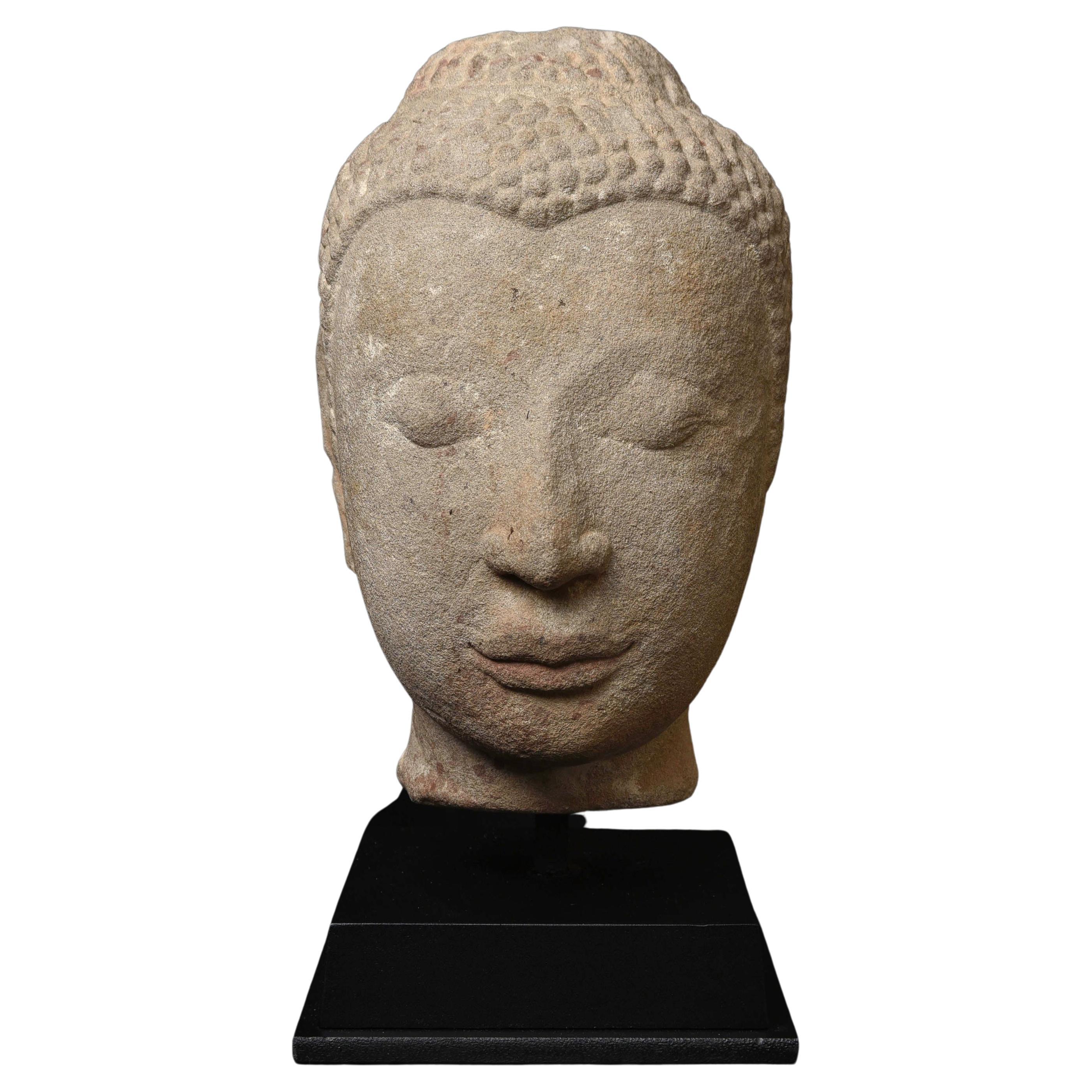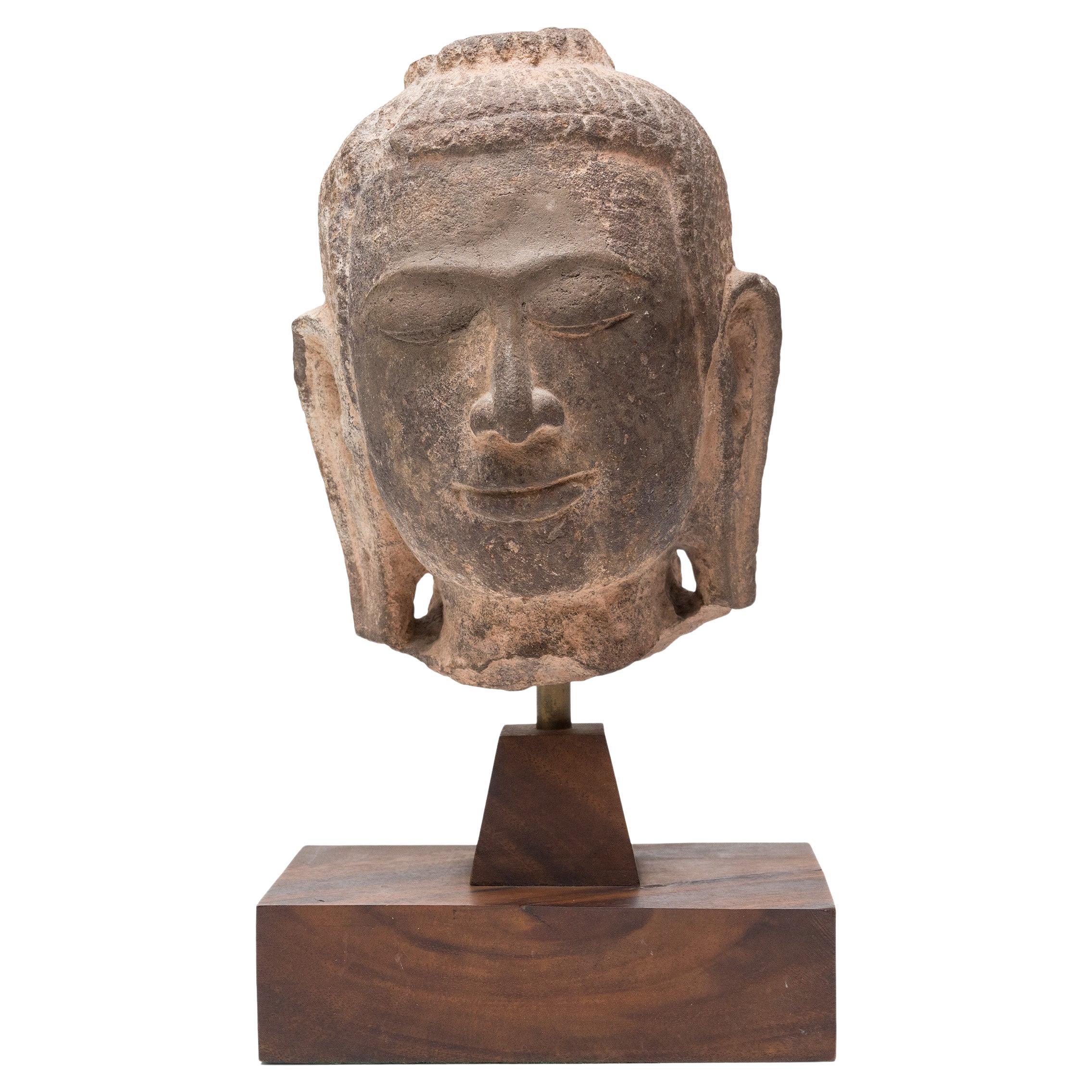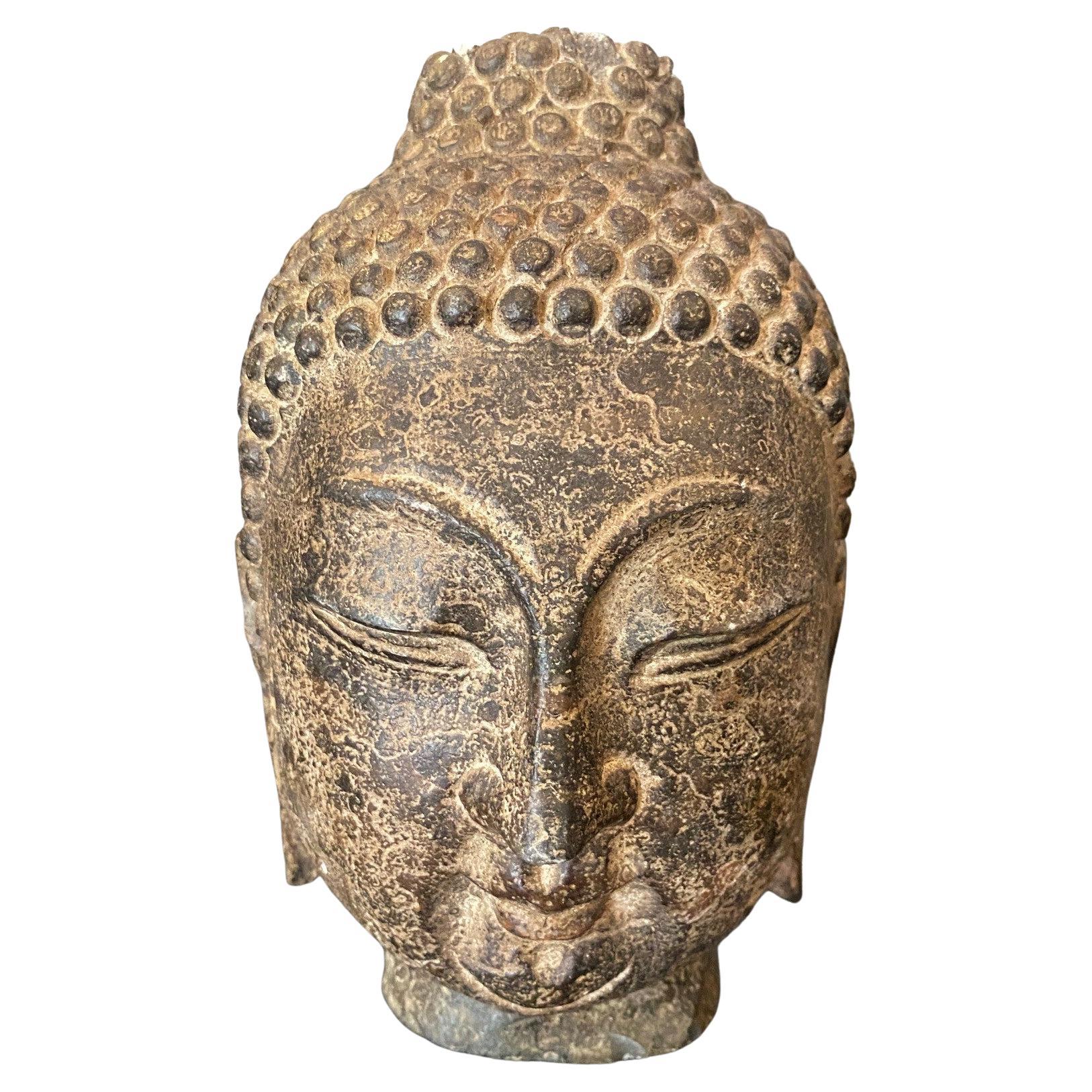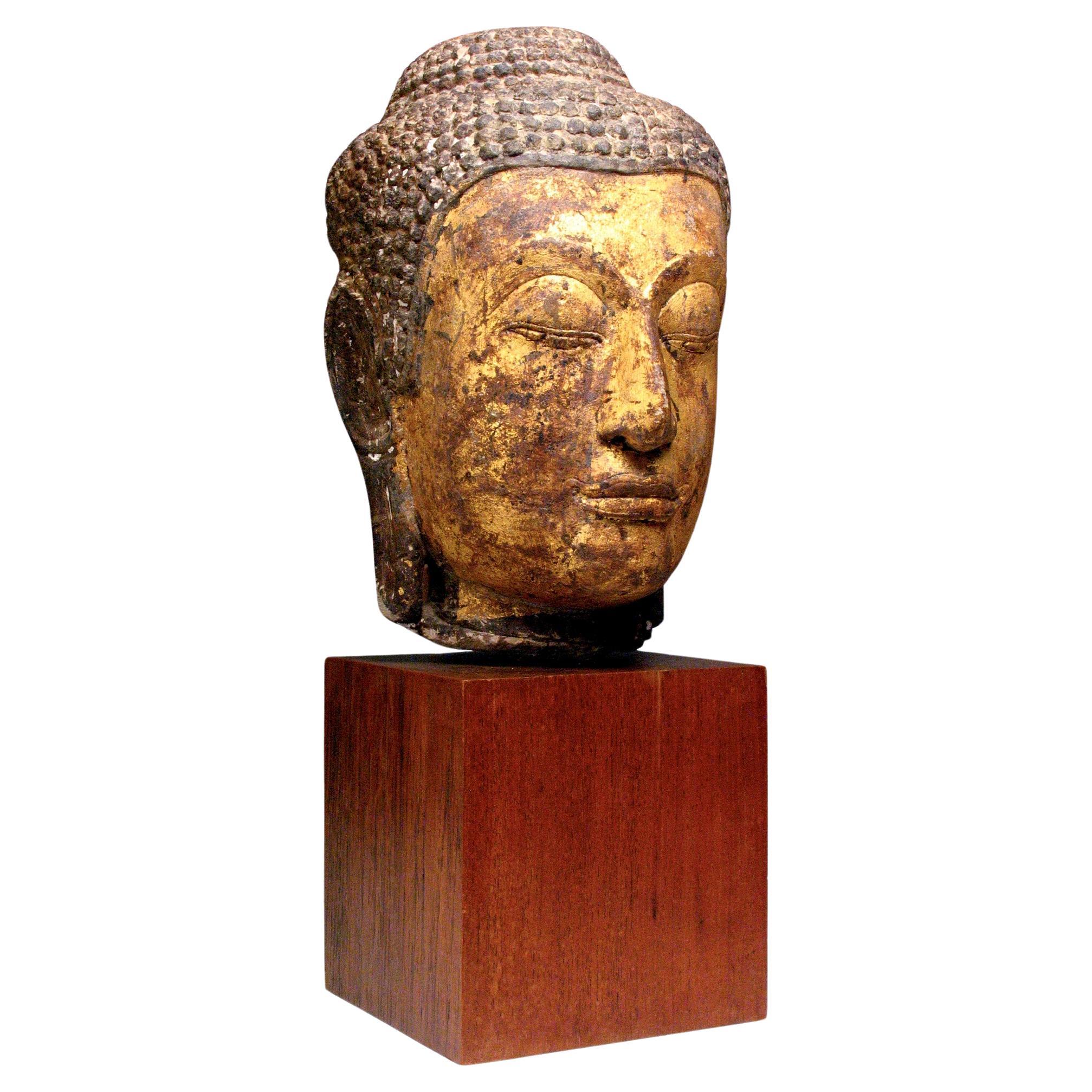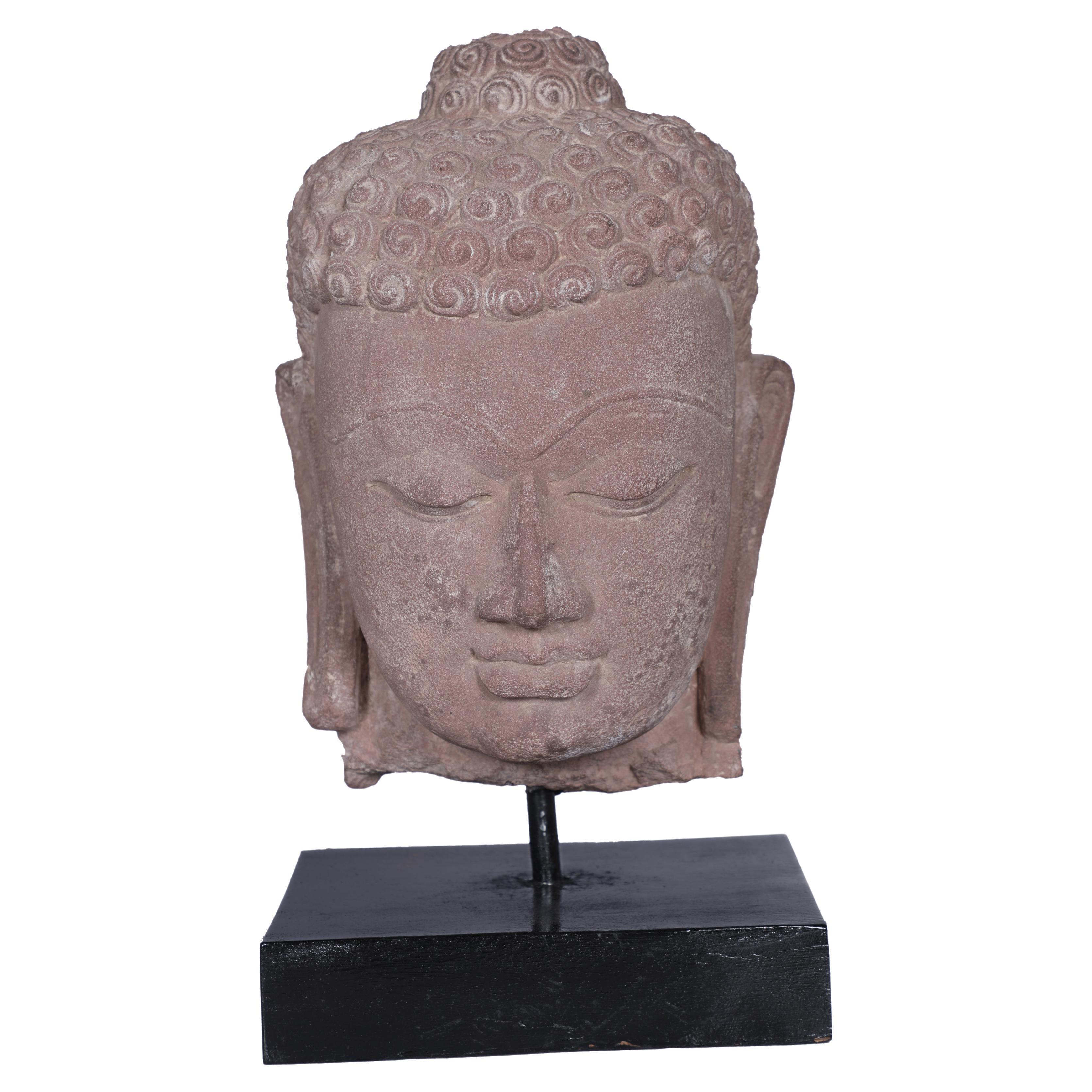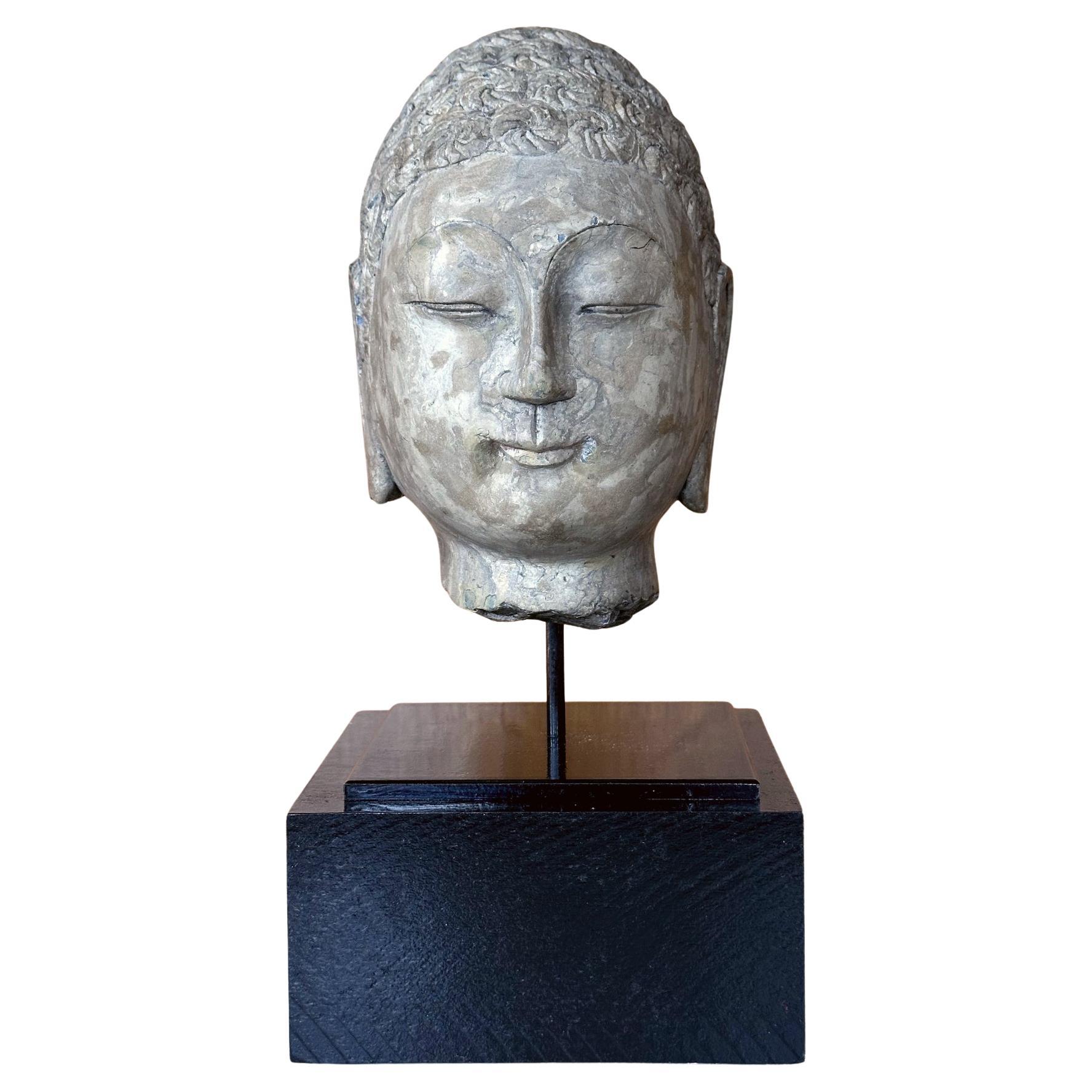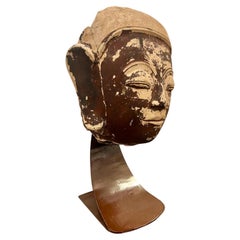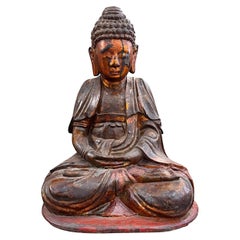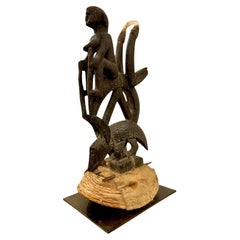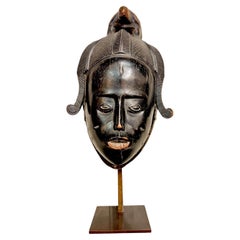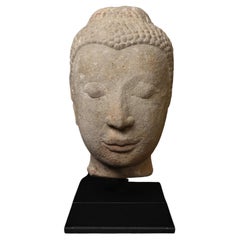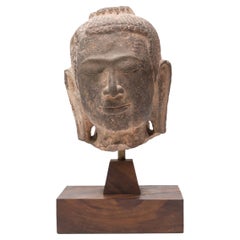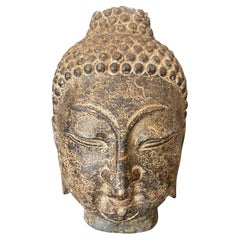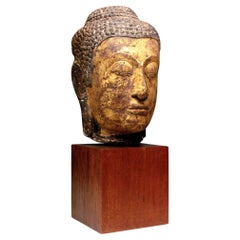Items Similar to Shakyamuni Buddha head in sandstone, Thailand, Ayutthaya, 17th century
Want more images or videos?
Request additional images or videos from the seller
1 of 14
Shakyamuni Buddha head in sandstone, Thailand, Ayutthaya, 17th century
$9,353.60
£6,958.13
€7,800
CA$12,808.27
A$14,241.05
CHF 7,435.89
MX$173,348.32
NOK 94,878.76
SEK 88,896.86
DKK 59,377.09
Shipping
Retrieving quote...The 1stDibs Promise:
Authenticity Guarantee,
Money-Back Guarantee,
24-Hour Cancellation
About the Item
17th century Thai Buddha head (Kingdom of Ayutthaya) carved on sandstone with a serene, delicate expression.
The finesse of the master sculptor's work is remarkable here: the large almond-shaped eyes with half-closed eyelids advocate introspection and humility, while the fine, well-defined mouth with pronounced corners preaches benevolence and universal love.
He wears the Ushnisha, a cranial protuberance characteristic of Buddha and a symbol of his knowledge.
This Buddha exudes emotion and wisdom, inviting the viewer's eye and mind to meditative calm and enlightened concentration.
This collector's item stands out for its fine craftsmanship and its expression of wisdom, from which emanates great spirituality.
Traces of gold on the stoneware.
The historic city of Ayutthaya, founded in 1350, was the second capital of the Siamese kingdom after Sukhothai. It enjoyed a period of prosperity between the 14th and 18th centuries, establishing itself as one of the world's largest and most cosmopolitan urban areas. Ayutthaya also played a key role as a center of diplomacy and international trade. In the early 16th century, European travellers ranked it among the three great Asian powers, alongside Vijayanagar in India and La Calle. Considered the forerunner of modern Thailand, the kingdom of Ayutthaya occupies a major place in the country's history. Its territory covered part of present-day eastern Myanmar (Burma), western Laos and as far north as present-day Malaysia. However, it was destroyed by the Burmese in the 18th century.
- Dimensions:Height: 6.38 in (16.2 cm)Width: 4.57 in (11.6 cm)Depth: 3.86 in (9.8 cm)
- Style:Tribal (Of the Period)
- Materials and Techniques:
- Place of Origin:
- Period:
- Date of Manufacture:Circa 1550
- Condition:Wear consistent with age and use.
- Seller Location:NICE, FR
- Reference Number:1stDibs: LU9202242476982
About the Seller
5.0
Gold Seller
Premium sellers maintaining a 4.3+ rating and 24-hour response times
Established in 2003
1stDibs seller since 2023
28 sales on 1stDibs
Typical response time: 5 hours
- ShippingRetrieving quote...Shipping from: NICE, France
- Return Policy
Authenticity Guarantee
In the unlikely event there’s an issue with an item’s authenticity, contact us within 1 year for a full refund. DetailsMoney-Back Guarantee
If your item is not as described, is damaged in transit, or does not arrive, contact us within 7 days for a full refund. Details24-Hour Cancellation
You have a 24-hour grace period in which to reconsider your purchase, with no questions asked.Vetted Professional Sellers
Our world-class sellers must adhere to strict standards for service and quality, maintaining the integrity of our listings.Price-Match Guarantee
If you find that a seller listed the same item for a lower price elsewhere, we’ll match it.Trusted Global Delivery
Our best-in-class carrier network provides specialized shipping options worldwide, including custom delivery.More From This Seller
View AllTerracotta Buddha head, Shan State Kingdom, Burma, 16th/18th century
Located in NICE, FR
Stoneware Buddha head, Shan State Kingdom, Burma, 16th/18th century
Buddha head from a temple facing built entirely of mud bricks during the 16th/18th century. Maravijaya Buddha. Sh...
Category
Antique 17th Century Burmese Medieval Sculptures and Carvings
Materials
Terracotta, Lacquer
Edo Period Vietnamese Seated Buddha Sculpture, 19th Century
Located in NICE, FR
A serene and evocative seated Vietnamese Buddha sculpture. Expertly hand-carved from wood, this statue captures the timeless grace and spiritual depth of Buddhist iconography. The Bu...
Category
Antique Late 19th Century Vietnamese Edo Sculptures and Carvings
Materials
Wood
Ciwara Bambara headdress in carved wood and basketry, Mali, Early 20th century
Located in NICE, FR
A very pleasing Ciwara crest, singularly small and accompanied by its original headdress, depicting a stylized antelope leaning on a pangolin. The antelope is ridden by a woman, and white horsehair has been added to the tips of the horns. The piece is carefully sculpted, with notches decorating the bodies of the antelope and the pangolin.
Rattan, plant fiber, cowries, wood Very fine velvety mat patina, Circa 1950
An animal called Ciwara is said to have taught the Bambara how to cultivate the land, and during agrarian ceremonies, they recall the myth through the stylized representation of an antelope whose name ci wara...
Category
Early 20th Century Malian Tribal Tribal Art
Materials
Wood
Ndoma Baule Portrait Mask, Ivory Coast, Wood, lacquered patina, Circa 1930
Located in NICE, FR
"Ndoma” Baule Portrait Mask, Ivory Coast, Circa 1930 Wood, heavy wood with deep brown-black lacquered patina.
A superb old hardwood dance mask featuring an ...
Category
Vintage 1930s Tribal Tribal Art
Materials
Wood
Bamana N'tomo mask, Mali, 20th century
Located in NICE, FR
Bamana N'tomo mask, Mali, 20th century
"Generally surmounted by three to eight horns forming a comb, the N'tomoface mask refers to a moment of compulsory education given to uncircumcised young boys in certain West African societies. The mask's discreet, even absent, mouth emphasizes the behavior expected of them in their future adult life after training: controlling and measuring their words, knowing how to keep quiet, preserving secrets and enduring pain in silence."
Excerpt from Masques du N'tomo, Marc Ladreit de Lacharrière Collection, Musée du Quai Branly Jacques Chirac, France.
The Bambara, or Bamana, live in central and southern Mali. Their name means “unbeliever” and was given to them by the Muslims. Animists, they believe in the existence of a creator god called Ngala, who maintains the order of the universe and coexists with another androgynous god called Faro, master of the Word, who gave all qualities to mankind and makes the fruits of the earth grow. Traditional Bamana art objects are closely linked to agrarian rites.
The Bamana dance these masks during initiation and circumcision ceremonies for young boys in the Ntomo society. The face, with its vertical outgrowths at the top, adopts geometric features beneath a rounded forehead, including an imposing busted nose, as the Bamana favor this organ in their statuary as it evokes sociability and clan cohesion. Indeed, during choreography, the dancer frequently touches the nose of the mask.
As teaching aids for candidates, masks from societies accessible to young boys and adults, such as the N'tomo, Korè and Ci wara...
Category
Vintage 1930s Malian Tribal Tribal Art
Materials
Wood
Late 17th Century Reliquary Bust of a Bishop in Gilded Wood
Located in NICE, FR
This exceptionally majestic and unique reliquary bust carved in gilded wood represents a bishop adorned in golden robes. The torso is draped in a toga revealing a round cavity that o...
Category
Antique Late 17th Century French Louis XVI Busts
Materials
Wood
You May Also Like
16th Century Thai Life Size Stone Buddha Head-Superb Ayuthaya Example
Located in Ukiah, CA
Life-size 16th century Thai stone head. The face is absolutely classic for this type--powerful, kind, and calm. The condition is very good, as can be seen in the photos. Large Buddhas...
Category
Antique 16th Century Thai Sculptures and Carvings
Materials
Stone
Limestone Shakyamuni Buddha Head, c. 1800
Located in Chicago, IL
With closed eyes and a gentle expression, this southeast Asian stone bust depicts the historic Buddha Shakyamuni in calm meditation. Also known as Shaka, Gautama Buddha, or Prince Si...
Category
Antique Early 19th Century Southeast Asian Archaistic Sculptures and Car...
Materials
Limestone
Stone Carved Asian Buddhist Temple Sculpture Statue Head of Buddha, 19th Century
Located in Studio City, CA
A wonderful hand carved stone-carved antique Southeast Asian Buddha head/bust temple/shrine sculpture, possibly from the Thai, Burma, Laos region but perhaps also Japan. The vintage...
Category
Antique 19th Century Asian Folk Art Sculptures and Carvings
Materials
Stone
Thai Sandstone Carving of the Head of A Buddha Image
Located in Point Richmond, CA
Thai Sandstone Carving of the Head of A Buddha Image, Ayutthaya, 15th Century. This sculpture has carved features with full lips outlined with an incised line known as a “trace”, the “U” of the chin broad, long aquiline nose , protruding large and arched eye lids with the eyes narrowly open revealing the pupils, over arching brow continuing the line of the nose, short forehead, a thin raised outline as the hairline surrounding the face, 6 rows of round boss hair curls to the domed usnisa covered in 5 rows of hair curls, large ears with attenuated earlobes reaching to the break at the neck, flat top to the usnisa and a flat area to the back of the head. The facial surface gessoed lacquered and gold leafed, the rest of the head with Varied surface mottling and lacquer remnants mostly revealing the sandstone texture of the material. Mounted with a post and drilled interior hole to a large solid teak block as a contemporary stand.
Condition: A sculpture fragment from a large Buddhist Image, The head has been removed at the neck and the flat area at the top of the head would indicate that another mortared segment would have originally been attached possibly an undulant unalom finial, otherwise remarkably fine.
Measuring: 23-1/8 inches high overall, the sculpture is 15 inches high x 10 inches wide x 10-1/4 inches deep. The wood base is 8-1/8 inches high x 7-7/8 inches wide x 7-5/8 inches deep.
Provenance:
with Kenneth Brown Jewelers...
Category
Antique 15th Century and Earlier Thai Other Sculptures and Carvings
Materials
Sandstone
Early 20th Century Sandstone Buddha Head, Northern India
Located in Nantucket, MA
A lovely sandstone Buddha head on wooden base, early 1900's, Utttar Pradesh, Northern India. The hand-carved features include the typical snail-s...
Category
Early 20th Century Asian Sculptures and Carvings
Materials
Sandstone
Stone Buddha Head Chinese Qi Dynasty on Custom Stand
Located in Atlanta, GA
Carved out of a single block of grayish brown stone (likely granite type), this Buddha head represents Northern Qi style in China (550-577AD) and likely of the period. The Northern Q...
Category
Antique 15th Century and Earlier Chinese Archaistic Sculptures and Carvings
Materials
Marble
More Ways To Browse
Gold Thai
Antique Well Head
17th Century Keys
Antique Sandstone
Buddha Head
Thailand Head
Sandstone Carved
Thai Carved Furniture
Hand Carved Thai Furniture
18th Century Stoneware
Large Thai Sculpture
17th Century Buddha
Antique Malaysia
Malaysian Antique Furniture
Large Buddha Head
Large Burmese Buddha
Thai Buddha Heads
Sandstone Head Sculpture
